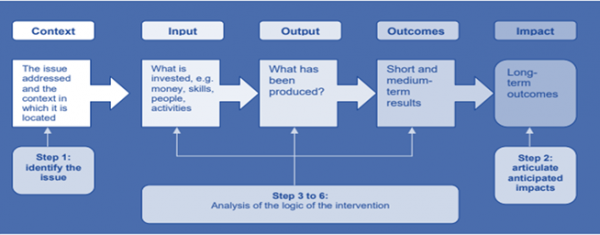What is an ILM
Designing and implementing policies, and building infrastructure, generate benefits for society but also impose costs. The ways in which these levers are designed and executed, therefore, need to be subject to a rigorous appraisal process. ILM illustrates how an intervention achieves its intended objectives by explicitly establishing the links between inputs, activities, outputs and the desired outcomes. This displays the “logic” by which the intervention is expected to work.
What does ILM do
Interventions are not desired for their own sake. They are the means to an end (or outcome). ILM helps to crystallise a policy problem or opportunity based on a systematic approach to identify and describe the causal links between the issues to be addressed, the intervention proposed and the outcomes to be delivered. The main purpose of carrying out an ILM is to ensure proposed interventions consider their effectiveness in delivering the outputs and outcomes sought. ILM also builds the foundation for a monitoring and evaluation plan by establishing a clear expectation about what is supposed to happen and why.
Key steps in ILM
An ILM should be conducted as part of the design and planning of new interventions. To conduct an ILM typically involves defining the issue or challenge, articulating the anticipated impacts, identifying inputs (what we buy or what we have), activities (what we do), outputs (what we produce) and how they link (logic) to the intended outcomes (the results).
For more information, please refer to the Ministry Intervention Logic Mapping tool [PDF, 791 KB] below.
 Getting the problem definition right
Getting the problem definition right
Government intervenes mainly for public interest reasons, such as due to market failure. Market failure refers to those situations in which the conditions necessary to achieve the market efficient solution fail to exist or are contravened in one way or another. The standard economic reasons for government’s intervention in transport include the following.
- Anti-competitive behaviours that limit the choice of transport service providers available to the public.
- Monopolies and natural monopolies that result in higher prices and lower output.
- The provision of boundaries for state-owned enterprises, or Crown entities, regarding their roles and legislative powers.
- The presence of externalities (i.e. benefits or costs that are not borne by those who take part in the activities) resulting in inappropriate demand for, and supply of, transport.
- The non-excludability of users due to the public good nature of road transport infrastructure resulting in free riding problems.
- Information inadequacies or asymmetries that impede transport users from making appropriate decisions (e.g. fuel consumptions information affecting vehicle purchase decisions).
- For social reasons, the government may also want to maintain the continuity and availability of services (e.g. public transport for remote communities).
Market failure is an important feature of observed markets. Left to itself, the market system of any economy is unlikely to operate efficiently. There will be a tendency for it to produce too much of some undesirable goods (e.g. transport emissions) and insufficient amounts of others (e.g. health services). Market failure may be a legitimate reason for intervention but it is not in itself sufficient. This is because intervention decisions often involve potentially complex interactions between multiple markets and actors.
The Institute for Innovation and Public Purpose at the University College of London promotes the market shaping approach to policy development. The market shaping approach emphasises making the best use of resources to achieve changes over time, including the creation of new technological frontiers. Because the system comprises of a complex set of behaviours, this approach focuses on systemic change to achieve dynamic efficiency (through process and product innovation over time) and considers a portfolio of interventions and their interaction. The role of government under the market shaping approach is to ensure markets support the wider social, economic and environmental outcomes and to involve users to co-create policy.
The market shaping approach is particularly relevant for justifying ambitious policies that aim to deliver transformative changes. The UK’s Future of Mobility: Urban Strategy used the market shaping approach to facilitate innovation in urban mobility for freight, passengers and services. Amongst the range of actions involved, the UK Department for Transport is building future thinking into their decision-making, carrying out public dialogue and surveys to understand public perceptions, encouraging the sharing and harnessing of transport data and building of local capability.
When applying the ILM, it would be useful to consider whether a problem is sufficiently ambitious to justify application of the market shaping approach. In such instances, the inputs and activities required would likely be broader than those offered under the traditional market fixing approach. Complex issues like climate change would benefit from incorporation of market shaping solutions (e.g. measures to encourage development of new forms of energy technologies) into the broader set of conventional measures (e.g. tax).
Using ILM to support evaluation
Evaluation is about making a value judgement on the performance of an intervention, with the purpose of providing evidence to inform future decision making. ILM sets the foundation for a monitoring and evaluation framework by establishing a clear expectation about what is supposed to happen and why. More details, such as evaluation objective, method, measures and indicators, could then be developed. Planning an evaluation early would ensure that appropriate resources and data capture mechanisms are put in place.
More resources will be added to the Evaluation toolkit(external link) on the Ministry of Transport website over time.
References:
Business Finland (2019), “Market shaping toolbox(external link)”.
Department for Transport (2019), “Future of mobility: Urban Strategy(external link)”, London, United Kingdom.
Ministry of Transport (2011), “Understanding Transport Costs and Charges, Phase two - Costs of Freight Transport: Legislation and Freight Transport(external link)”, Wellington, New Zealand.
Rainer, K, Mazzucato, M, Ryan-Collins, J and Sharpe, S (2018), “The economics of change: Policy and appraisal for missions, market shaping and public purpose(external link)”, Working Paper IIPP WP 2018-06, Institute for Innovation and Public Purpose, University College of London.